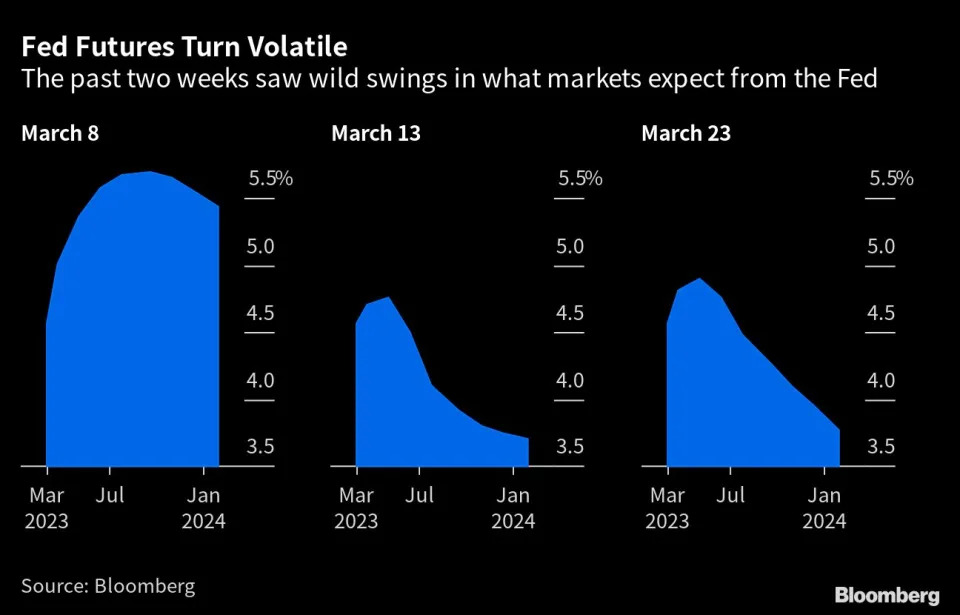
(Bloomberg) - History remembers Paul Volcker as the slayer of inflation, and Ben Bernanke as the crisis firefighter. Jerome Powell is in danger of having to play both roles at once — or, what may be worse, to choose between them.
On the face of it, Powell’s Federal Reserve this week pushed ahead with what’s been its policy for the past year — raising interest rates to bring down inflation — and so did other major central banks. But in reality everything’s changed, after a string of bank collapses sent tremors through world markets.
Just a couple of weeks ago, threats to financial stability barely registered on the troubleshooting list for central bankers. Now they’ve rocketed toward the top. Powell and his peers say preventing a re-run of the inflationary 1970s remains priority number one. But the signal is shifting.
The Fed only hiked by half as much as it was expected to before the collapse of Silicon Valley Bank and the shotgun takeover of Credit Suisse Group AG. The European Central Bank followed through with its planned half-point hike, but backed away from giving much guidance as to what comes next.
Investors are having trouble figuring that out, too — as shown by the dramatic swings in market bets on monetary policy over the past couple of weeks. They’ve gone from pricing an aggressive Fed that hikes several more times, to a “we’re all doomed” scenario of imminent rate cuts after SVB’s failure — to only a shade less doomy right now.
The Goldilocks scenario would be for financial conditions to be just tight enough — as banks dial back lending and shore up their own balance sheets — to do some of the Fed’s inflation-fighting work for it. That would help cool an overheated economy the way Powell wants, and reduce the need for rate hikes. Central-bank tools to control prices and prevent financial breakdown could work separately and effectively.
All very well — but the basic problem for monetary chiefs is that, in extremis, policy prescriptions for taming prices and bolstering banks point in opposite directions. To get inflation down, central banks jack up rates and withdraw liquidity from the banking system. To short-circuit crises, they shove money out to stricken lenders and cut the cost of credit.
And the danger is that they end up with the worst of both worlds: A full-blown crisis that triggers a recession. That would force central banks to abandon the inflation fight before it’s finished, as they rush to shore up a teetering financial system.
‘Turn for the Worse’
“The tension between fighting inflation versus preserving financial stability is now more stark than any time in the Fed’s history,” says Anna Wong, chief US economist at Bloomberg Economics — drawing on a study of American banking crises over the last 140 years.
For tighter credit to take a decent-sized bite out of inflation, “the current crisis would have to take a significant turn for the worse,” she says. And if that doesn’t happen, “markets will have to revise up their estimates for the Fed’s policy path.”
Central bankers are themselves partly to blame for the unpalatable choices they now face.
An extended period of near-zero interest rates fostered complacency and risk-taking throughout the financial markets and economy. That’s now coming to a head as monetary policy makers ramp up rates to get on top of an inflation problem they were slow to recognize.
“Super-easy monetary policy created the dry tinder for the financial turmoil,” says former Fed Governor Kevin Warsh, who’s now a senior fellow at the Hoover Institution. “The massive reversal in policy was the trigger.”
For a while, it looked like the financial system — fortified by reforms after the 2007-09 crisis — would be able to withstand the end of easy money. The crypto market blew up, but the central pillars seemed sturdy.
But now strains have spread to the banks — and in a way that illustrates how each episode of financial unrest tends to differ from its predecessor.
‘Pretty Serious’
Silicon Valley Bank, the 16th-largest lender in the US, didn’t make a ton of risky loans to homebuyers. Instead it loaded up on Treasury debt, supposedly the safest asset around. But then it got hit by a double whammy. The Fed’s rate increases pushed the value of those bonds deep into the red — while also hurting its depositor base in the tech industry. The upshot: SVB was wound up by the Federal Deposit Insurance Corp. on March 12.
Credit Suisse Group AG was the next big domino to fall. For years investors had fretted about weaknesses at the Swiss lender. The slow slide turned into sudden collapse, as the bank’s shares plunged and bets on a default surged. It got taken over by neighbor and rival UBS Group AG on March 19, at a rock-bottom price. Holders of some $17 billion in debt got wiped out.
As investors survey the debris, a credit crunch has replaced stubborn inflation as the key risk, according to Bank of America’s latest global survey of fund managers.
“The market is acting as though we’re in the middle of a pretty serious crisis,” says Ethan Harris, BofA’s head of global economics research. “It’s putting a very high weight on an adverse scenario where you have a big financial event and a very bad economy.”
Bloomberg terminal users can see scenarios for how moderate and extreme financial stress would impact Fed policy in SHOK.
In what sounds a lot like the assurances made ahead of the financial crisis 15 years ago, US authorities are insisting that they’re on top of the situation.
They’re arguing that the banking system as a whole is a lot stronger than it was back then, with much more capital and liquidity. They’re maintaining that many of the problems seen so far were peculiar to the institutions involved, and not a sign of broader and deeper difficulties.
Significantly Fragile
Not everyone is so sure about that. At the end of last year, US banks had $620 billion in unrealized losses on securities, according to the FDIC. In a March 13 paper, a group of academic economists calculated that hundreds more banks could end up in the red in the event of a massive flight of deposits.
“Recent declines in bank asset values very significantly increased the fragility of the US banking system to uninsured depositor runs” like the one that destroyed SVB, they wrote.
Central bankers also contend that they have separate tools to contain financial turmoil and tame prices, which can be used simultaneously. That idea harkens back to the late Dutch economist Jan Tinbergen, who won the first Nobel Prize for economics in 1969. His rule — one that Bernanke adopted in the early 2000s — posited that policy makers need to use different instruments to achieve different aims.
Right now, for example, central banks can support beleaguered lenders with dollops of short-term liquidity, while also raising interest rates for borrowers throughout the economy to slow inflation. The Fed has doled out hundreds of billions of dollars through various backstop facilities over the past two weeks, data out Thursday showed.
The central bank’s balance sheet exists precisely to deal with such emergencies — but the problem is that the Fed is trying to pare back its bond holdings, swollen after years of buying securities under the policy known as quantitative easing. For two weeks now, the liquidity injections mean it’s effectively been doing the opposite.
That shouldn’t be taken as an easing of the Fed’s stance, Powell told reporters on Wednesday. The argument is that short-term liquidity provision, and asset purchases or sales aimed at shifting longer-run borrowing costs, are different things. Many seasoned Fed watchers agree — but that hasn’t stopped money managers from latching on to it as a signal of looser policy ahead.
Out of Control?
The result, says former Fed governor Warsh, is a muddied message that confuses markets and makes it harder for policy makers to get a grip on inflation. Case in point: Investors are ignoring Powell’s repeated attestations that the Fed has no plans to lower rates this year, and trading as if cuts are baked in.
Even if monetary policy makers do succeed in staunching the latest financial turmoil, they acknowledge that it’s still likely to squeeze the economy. The key question is: how much?
At his press conference after Wednesday’s 25-basis-point move, Powell suggested that tighter financial conditions might be “the equivalent of a rate hike, or perhaps more than that” — quickly adding a caveat: the assessment can’t currently be made “with any precision whatsoever.”
That hasn’t stopped economists on Wall Street and elsewhere from trying. Using SHOK — Bloomberg’s model of the US economy— Wong calculates that the banking stress seen so far is likely equal to a 50-basis-point increase in interest rates. Other estimates run as high as 150 basis points.
Whatever the answer, the underlying problem is the same: it’s something the Fed can’t fine-tune. Powell and his colleagues are trying to steer the world’s biggest economy out of an inflationary episode and back to steady growth. The job just got much tougher.
“Ideally the Fed would like to be able to manage this process carefully,” Bank of America’s Harris says. Now, “you have to be worried that the recession is going to be deeper and harder to control.”
By Rich Miller
With assistance from Alexandre Tanzi, Alexander Weber and Philip Aldrick




